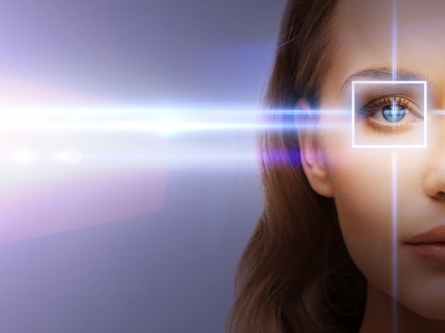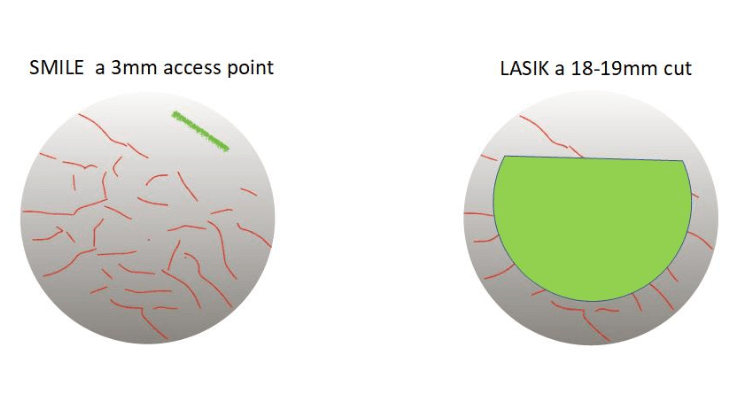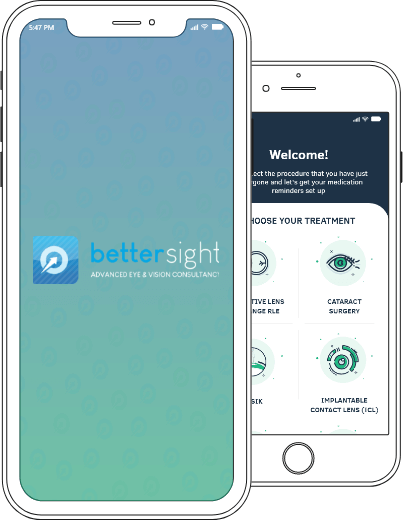

Quite probably the safest and most effective surgical procedure ever created by humankind
or you can download my guide to State of the Art Vision Correction Treatments -2020 and BeyondMr S. Rehman


First, let me dispel a common misconception, that Laser vision correction is a cosmetic treatment. Quite simply, this is incorrect, because I and my whole team are very clear that Laser vision correction is a truly transformative treatment. The impact it can have can be quite literally profound and so much more than just looking better without glasses - although of course you may well do that as well!
Perhaps you’ve been wearing glasses for a few years, maybe you’ve been wearing them for decades or even since early childhood. Whilst you may have got used to them, they might still be a bit of a “pain” so to speak.
Glasses slip off your nose, they make playing sports more difficult, or get knocked off your face when playing with your children? Steaming up when going indoors to a restaurant from the cold outside. Many of us will tolerate glasses for a while but very few actually REALLY WANT to wear glasses (if you do – that’s great by the way!) We can often feel slightly less confident, less self-assured, less ‘us’ with them on – even though of course we shouldn’t.
Contact lenses are a great way to hide your glasses from the world – but the constant inserting, removing, caring for them can become a bit of a bind too. Never mind the tired, achey eyes at the end of the day, losing a contact lens and having to ‘fish’ for it is not a lot of fun is it?
So imagine if we were to say that there is an excellent chance your eyes could be treated so that you were free from glasses and contact lenses – consigning them to that box called ‘The past’? That really is the promise of modern vision correction procedures. How would that make you feel?
Vision correction is as much an art as it is a surgical science – there are so many different procedures out there and every company says they are the best – better than all the rest?
Laser vision correction treatments have been with us for over thirty years now. In that time major developments have taken place. Enormous positive changes have taken place due to extensive research and development which means that today Laser vision correction is quite probably both the safest medical procedure AND the most effective procedure in the world.
In the table below I outline some of the key differences between the three major types of Laser vision correction - LASEK, LASIK and the most recent development SMILE.
There are three major types of laser eye surgery LASEK, LASIK and SMILE. But what are the differences between them?
| Lasek | Lasik | Smile | |
|---|---|---|---|
| Established | c. 1989 | c. 1991 | 2006/7 |
| Post op pain | Significant | Minimal | Minimal |
| Vision Recovery | 7-10 days | 1-2 days | 1-2 days |
| Myopia Treatment | Up to -6D | Up to -9D* | Up to -10D* |
| Hyperopia Treatment | Up to +1.5D | Up to +4.00D* | Not yet |
| Astigmatism | Up to 4D* | Up to 6D* | Up to 6D* |
| Impact on corneal strength | Low | Moderate | Lowest |
| Impact on corneal nerves | High | Highest | Lowest |
| Resistance to eye trauma | High | Moderate | Highest |
| Return to activity | Slow | Quick | Quickest |
| Return to work | Slow | Quick | Quickest |
| Monovision possible? | Yes | Yes | Yes |
*Classified as complex treatments

In order to fully understand where SMILE fits in with todays laser vision correction options we have to firstly understand the history of laser corrective surgery.
The very first laser treatments were carried out on the surface of the cornea. However in order for the treatments to be effective, removal of the corneal epithelial layer was required. This was initially done mechanically using a bladed instrument (PRK) but later Alcohol solution was discovered to be very effective in allowing clean removal of the epithelium without any sharp instruments being required. Although these treatments are effective in low to moderate myopia, they do come with a great deal of pain afterwards and a much slower recovery.
A corneal flap was originally conceived as a means of allowing patients to gain rapid recovery and with very much less pain than would occur when ‘surface’ ablation techniques such as the first generation of laser vision correction treatments – PRK and later LASEK. This is because the flap retains the epithelial layer on its surface, which means the reshaping and re-contouring is performed in the layer underneath the flap. When the flap is repositioned, eye sight starts recovering almost immediately and the protective epithelium layer present on the top surface of the flap means only a few hours of mild irritation and not severe pain as is the case with LASEK/PRK.
So LASIK was a major step forwards for our patients – no question about that.
LASIK was the predominant option for people considering laser vision correction for the best part of nearly 3 decades. However the search for a FLAP-LESS form of laser vision correction was on-going, preferably one that did not come with the obvious drawbacks of LASEK/PRK treatment!
From around 2007 onwards the concept of SMILE was first conceived and has now been available for just over ten years now. SMILE is able to take advnatage of the incredible precision of ultra short duration infra-red wavelength laser systems, generally referred to as femtolasers. A femtosecond is a extremely short duration of time – in fact if one femtosecond was scaled up to one second, then the equivalent time for one second would be around 32 million YEARS!.
Ultrashort duration, precise energy and precisely positioned laser pulses in the cornea can very precisely create tissue planes, in fact a similar technology has been in use to create LASIK flaps for nearly twenty years now.
In SMILE, we are able to use this incredible technology to accurately create tissue planes inside the cornea at a precise, pre programmed depth (usually 0.12 to 0.13mm) inside the cornea and then connect this layer of tissue to the outside of the cornea. This tissue plane is called a lenticule, and it is remvoal of the lenticule that effects the prescription change that is desired.
It should therefore be apparent that SMILE is quite different from LASIK.
The diagrams show the impact of SMILE v LASIK on the microscopic nerve structure which innervates the cornea. These nerves are involved in complex feedback loops with the tear gland and are therefore implicated in the creation of dry eye symptoms.
The nerve ‘plexus’ radiates inwards from the edges of the cornea with a branching pattern as shown. But the key point to remember is that the nerve plexus is most dense in the most superficial part of the cornea.
In LASIK the nerve plexus is affected by the flap cut. Although nerves do grow back, they tend to do so quite slowly – sometimes over 12-18 months. During this phase nerve plexus damage could be an aggravating factor in dry eye symptoms.
Clinical research has shown that patients undergoing SMILE experience less dry eye symptoms and for a shorter duration of time. This is most likely as a result of less nerve plexus damage occurring in SMILE as compared to LASIK.
In addition there are noteworthy advantages in SMILE with respect to keeping the corneal biomechanics (in simple terms how strong the cornea remains) with like for like corrective treatments leaving the cornea around 28% stronger than in LASIK. Finally the absence of a flap means that any eye contact, eye rubbing, eye trauma is much less likely to adversely impact your eyes after SMILE as compared to LASIK.
It is therefore obvious that SMILE and LASIK whilst both producing excellent vision improvement prospects and with little or minimal discomfort are quite different in how they are able to deliver the treatment to your eyes.
Not every eye is suitable for SMILE – most notably at the present time , SMILE is not licensed for LONG sightedness (hyperopia) but where both options are available, we want you to understand the differences so that you can make an informed choice.
Quite possibly it is the surgeon who performs your treatment that will have the single biggest impact on the outcome of your procedure, not the hospital, not the clinic, not the brand - it really is the surgeon
Ask yourself What is it that you need from your eye surgeon?
You might consider some or all of the following to be important or even essential requirements for the person you choose to be your surgeon.
Years of Laser vision correction experience? An unflappable, calm, reassuring 'bedside' manner? Someone who really cares for your result? Someone who is approachable and easy to talk to? Someone who will work with you to create a customised treatment plan that is best for you? Someone acknowledged by their peers and by their organisation to be at the top of their field?
You might consider some or all of the following to be important or even essential requirements for the person you choose to be your surgeon.
With Mr. Rehman, as Ambassador Consultant to Optegra Eye Hospitals, Chairman of the Medical Advisory Board and former clinical director of the Vision Correction service - you can be sure that all boxes are ticked!
Mr Rehman will oversee every stage of the pre operative workup and the post operative assessments and leaves nothing to chance in order to help you achieve an excellent result.
Although laser vision correction treatments have been available for 30 years now, its no surprise that huge developments have taken place in those 3 decades.
Very broadly we can consider LASEK/PRK to be the first generation treatment which has been around for 30 years, LASIK to be the second generation treatment which has been available for over 25 years and SMILE to be the third generation Laser corrective treatment that has been available for around ten years now.
Laser vision correction is a surgical procedure which uses advanced laser systems to alter the shape of the cornea in order to correct your spectacle / contact lens prescription.
LASIK – is an acronym – LAser in SItu Keratomileusis. This is a technique involving the creation of a hinged flap on the cornea – typically about 0.11mm thickness and around 8-9mm in diameter. The flap is reflected and this allows the underlying tissue of the cornea (called the stroma) to be reshaped by a computer controlled, tracker driven Excimer laser system. Tissue removal in defined patterns is what leads to the correction of the prescription.
SMILE is an acronym – Small Incision Lenticule Extraction. The principle in SMILE is to remove a precisely sized and shaped piece of corneal tissue from within the cornea via a small incision. The technology that allows for this level of precision has been available in its current form for around ten years now. At present SMILE is licensed only for Myopia (short sightedness) and for Myopic astigmatism. We do however expect SMILE to evolve to allow treatment of Hyperopia (long sightedness ± astigmatism) in the near future.
Anyone who has a strong motivation to enjoy a life without having to rely on glasses / contact lenses could be suitable for laser vision correction. People under the age of 18 are however not advised to consider laser vision correction. Equally certain medical conditions such as rheumatoid arthritis or other ‘connective tissue’ disorders, glaucoma, cataract, Iritis, some medications such as powerful immune suppressants/ Ro-accutane for acne can be contraindications to laser vision correction. If you’re unsure – just drop us a line and we can clarify your situation.
In simple terms – NO - most patients report an experience often described as ‘a bit weird’ ‘like being in a sci fi movie’ - very few report significant discomfort during surgery. This is because numbing eye drops are used to carry out laser vision correction – whichever type of surgery you are having.
Yes – we do recommend a light sedative – typically a low dose of Diazepam, similar to what many nervous flyers will take before airplane journey. The effect of this is to help you feel more relaxed prior to the procedure. You are still awake and in control but you will feel more ‘chilled’ about the process. You do not have to have this but it is something we like to offer.
Some eye movement is perfectly manageable, you do not have to be staring in one precise position throughout the procedure! For LASIK and LASEK the excimer laser has a built-in high speed eye tracking device which will track your eye and deliver the treatment exactly where it is programmed. In SMILE – the eye is actually kept still for you with a light pressure device and you are asked to look directly at a green flashing light – the entire process of laser delivery in SMILE is around 25 seconds.
You don’t have to! A simple device is used to keep your eye open so you don’t have to. You will still be able to blink naturally – but only the ‘other’ eye will actually blink, the eye under treatment will not close once the speculum is in place.
We always advise our patients to go home, take a nap for an hour or two as your eyes may feel a little ‘stingy’ in the first few hours post op. Use the eyegoggles for sleeping in for up to a week, do not get water in your eye for around a week, refrain from vigorous sports for at least a week and try not to rub your eyes – especially after LASIK or LASEK. Do remember to use the prescribed eyedrops – you can set reminders using our ‘bettersight’ app to help with this.
Most people are able to see some difference within a few hours after LASIK or SMILE. I find most patients are around the 80-90% of their full recovery within 48 hours with the remaining 10-20% vision potential developing over the subsequent 2-4 weeks. For patients who have LASIK for hyperopia – this process may be lengthened a little, and those undergoing LASEK will also find a slower upwards vision trajectory over several weeks.
In general, the upper limit for myopia treatment with LASIK or SMILE is circa -10D. For hyperopia, the upper limit is +4D and for astigmatism it is ±4D. At or beyond these levels we would normally ask you to consider ICL – implantable contact lens treatment or Refractive lens exchange (if above age 45).
EXTREMELY UNLIKELY!! There have been NO reports of blindness arising immediately and simultaneously to both eyes FROM laser vision correction. With well over 50,000,000 treatments worldwide over the last 30 years, we think it’s fair to say the risk of a dreadful complication such as this arising is probably not dissimilar to the risk of being involved in a serious air plane accident.
If the treatment is carried out, then you will achieve a result. No result is only possible if the treatment is aborted early. If the result is not to your satisfaction and so long as there are no contra-indications, an enhancement procedure can be considered in most cases.
If you have had LASEK/PRK it would most likely to repeat LASEK/PRK that is appropriate.
For those who have had LASIK – a flap lift enhancement approach is often most suitable.
For patients who have undergone SMILE – repeat SMILE, conversion to LASIK or LASEK/PRK can be options.
Either way our focus is on achieving the best possible result for you and all options will be considered where required. Note – enhancement laser vision correction is generally performed between 4-12 months post operatively, only around 2% of our treatments will require enhancement.
Many eye doctors, opticians, surgeons and dentists have had laser vision correction, equally many have not. It all comes down to personal motivation. Many people who require glasses / contacts are comfortable in continuing with this way of life and that is absolutely fine. Its important for YOU to have the required motivation to consider undergoing any type of vision correction procedure. It is after all a deeply personal choice and if you come to my service I and my team will do our very best to help you get the result you want in the safest way possible.
Total patient support- in the palm of your hand.
